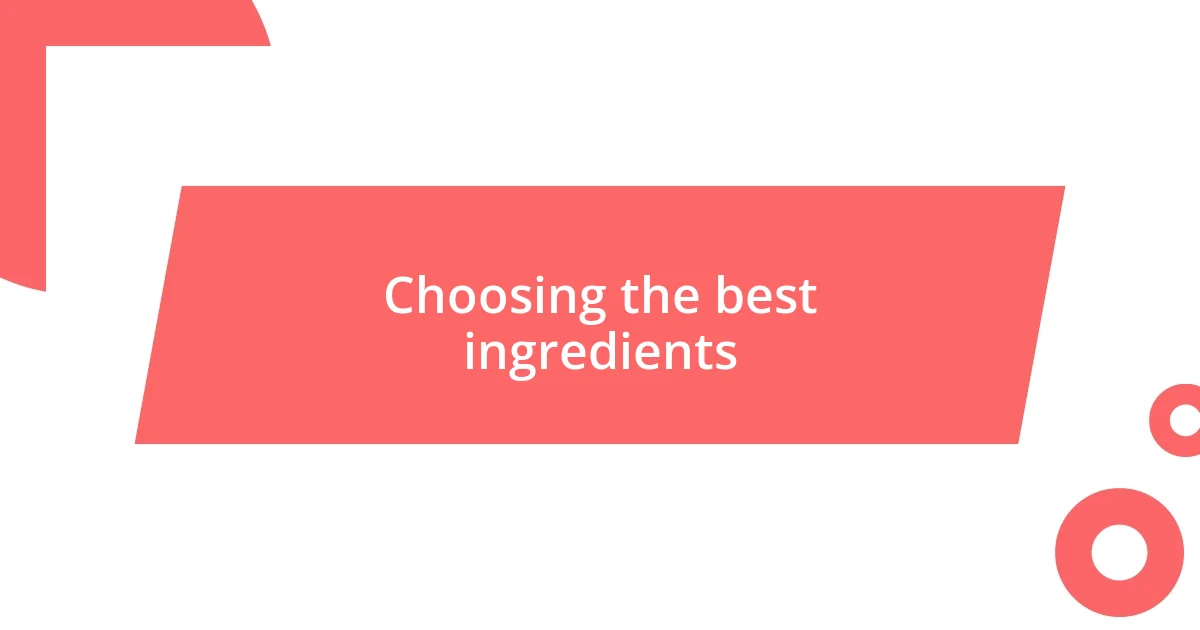Key takeaways:
- Outdoor cooking is about creating memorable experiences, encouraging experimentation with flavors and techniques, and learning from mishaps.
- Essential tools for successful outdoor cooking include a quality grill, cast-iron skillet, long-handled utensils, sharp knife, food thermometer, and cleaning supplies.
- Preparation, temperature control, and food safety are crucial to overcoming common cooking challenges and ensuring a positive outdoor cooking experience.

My outdoor cooking journey
The first time I attempted outdoor cooking, I can still vividly recall the excitement mixed with the fear of failure. I was camping with friends, and while they were roasting hot dogs, I decided to take on the challenge of cooking steak over an open flame. Would the meat turn out tender or would I end up with a charcoal brick? The smell of that sizzling steak was intoxicating, and I learned that a little patience and the right technique can make a meal unforgettable.
As I continued my outdoor cooking journey, I discovered the sheer joy of experimenting with various flavors. One evening, a simple campfire turned into an impromptu Italian feast with garlic, rosemary, and fresh vegetables tossed into my trusty cast-iron skillet. Can you imagine the satisfaction of cooking something delicious while surrounded by nature? That moment really solidified my passion for outdoor cooking; it’s about creating experiences as much as it is about the food.
Now, I look back on those early days with a mix of fondness and humor. From overcooked pasta to the infamous burnt s’mores incident, each blunder taught me valuable lessons. I realized that every outdoor cooking mishap is just another opportunity for growth. Who would have thought that learning to cook outside would teach me so much about resilience and creativity?

Essential tools for outdoor cooking
When it comes to outdoor cooking, having the right tools can make all the difference between a culinary success and a frustrating experience. I remember my first attempt at grilling; I used a flimsy spatula that couldn’t handle flipping the burgers. It fell apart under pressure, and I ended up with a mess! That was a turning point for me. Investing in reliable, durable tools not only enhances the cooking experience, but also boosts my confidence in the great outdoors.
Here’s a list of essential tools I’ve come to rely on during my adventures:
- Quality Grill or Portable Stove: A solid grill or stove ensures even cooking and allows for versatile meal preparation.
- Cast-Iron Skillet: This sturdy piece can be used for searing, sautéing, or even baking over coals, adding depth to your meals.
- Long-Handled Utensils: Tongs and spatulas with long handles let you maintain a safe distance from the flames while flipping and serving.
- Sharp Knife: A good knife is essential for prepping ingredients, from cutting veggies to slicing meats.
- Food Thermometer: This ensures your meat is cooked to perfection, which is especially crucial when cooking outdoors where heat control is tricky.
- Cleaning Supplies: Don’t forget towels, biodegradable soap, and a garbage bag for the aftermath—keeping nature clean is part of the experience!
With these tools, I feel equipped to tackle any outdoor cooking challenge, allowing me to focus on enjoying the food, friends, and the breathtaking environment around me.

Perfecting your cooking techniques
Perfecting your cooking techniques involves understanding the basics, adjusting to your environment, and embracing experimentation. I vividly recall a rainy day that turned into an unexpected lesson. While trying to grill chicken on a misty afternoon, I quickly learned the importance of temperature control and knowing my grill. My eagerness to cook didn’t align with the reality of grill heat fluctuating due to the weather. It taught me to not rush things; patience, I’ve since discovered, yields the best results.
As I experimented more, I found that mastering different methods, like grilling or smoking, transformed my meals. One windy evening, I felt inspired to try smoking fish using cedar planks. I added herbs and spices, creating a symphony of flavors that danced on my tongue. The thrill of discovering how smoke can elevate a dish forever changed my approach to cooking outdoors, making me a more adaptable cook. Isn’t it fascinating how the environment can influence your cooking?
Another technique that I now swear by is practicing mise en place, a French culinary term for “everything in its place.” I recall camping with friends and forgetting a key ingredient which resulted in a last-minute scramble. Since then, I prepare my ingredients ahead of time: chopping vegetables, marinating proteins, and measuring spices, so I can focus exclusively on the cooking process instead of running around looking for things.
| Technique | Description |
|---|---|
| Temperature Control | Understanding and adjusting the heat for even cooking is crucial, especially outdoors where conditions can vary. |
| Experimentation | Trying new methods like smoking, grilling, or baking can enhance flavors and lead to unexpected deliciousness. |
| Mise en Place | Preparation and organization of your ingredients helps streamline the cooking process and reduces chaos. |

Choosing the best ingredients
Choosing the best ingredients can feel like piecing together a puzzle; each one plays a crucial role in the overall dish. I still remember a camping trip when I decided to experiment with fresh produce from a local farmer’s market. The vibrant colors and rich scents of ripe tomatoes and fragrant herbs inspired me to create a simple but unforgettable salad that helped everyone enjoy their meal. It was in that moment I understood how quality ingredients can elevate even the simplest dishes.
When I shop for ingredients, I focus on seasonal produce. It always amazes me how the flavor of vegetables and fruits can vary throughout the year. For instance, I once tried to make a pumpkin soup in the summer and ended up with bland and disappointing results. Now, I plan my outdoor meals around what’s in season, resulting in brighter, bolder flavors and the added satisfaction of supporting local farmers.
Another tip I’ve picked up is to pay attention to the origin of my ingredients. Once, I used some herbs that I thought were fresh but turned out to be stale—what a letdown! Now, I seek out local spices and ingredients whenever possible. Not only does it enhance the flavor, but it adds a unique story to my outdoor cooking experiences. Have you ever considered how much more exciting a dish is when you know where it comes from? I find that connection to the food makes every bite more meaningful.

Exploring different cooking methods
Exploring different cooking methods can be an exhilarating journey filled with new flavors and experiences. One time, I decided to try my hand at Dutch oven cooking during a winter camping trip. With the fire crackling, I carefully placed a pot of stew over the coals, allowing it to simmer for hours. The aroma of savory meats and vegetables wafted through the chilly air, and when we finally dug in, it felt like a cozy hug after a long, cold day. Have you ever stumbled upon a method that just felt right?
Another method that piques my interest is open-fire cooking. The first time I attempted this, I was nervous. I remember skewering chicken and vegetables, then slowly rotating them by the flames. The challenge of cooking over an open flame forces you to stay engaged and attentive, turning a simple meal into an adventure. The taste? Unmatched. It’s that smoky, charred essence that sets open-fire cooking apart from any other method. Isn’t it interesting how the primal act of cooking over fire invokes a sense of connection to our ancestors?
Lastly, let’s talk about the increasingly popular sous vide technique. I still laugh when I think of my first attempt: I placed vegetables in a plastic bag, carefully submerging them in hot water, only to realize hours later that I had set the temperature way too low. When I finally got it right, the results were nothing short of revelatory. The colors were vibrant, and the flavors intensified in a way I hadn’t anticipated. Have you tried sous vide cooking yet? It’s a game-changer for achieving consistent results, especially outdoors where conditions can be unpredictable.

Tips for outdoor cooking success
When it comes to outdoor cooking, preparation is key. I’ve learned the hard way that having a well-organized cooking station can save both time and frustration. On one particularly chaotic camping trip, I fumbled through my gear looking for utensils, and it completely derailed my dinner plans. Now, I make sure everything I need is easily accessible, letting me focus on the joy of cooking in the great outdoors rather than scrambling to find my spatula. Isn’t it amazing how a little preparation can transform the experience?
Temperature control is another vital factor I can’t stress enough. I recall a delightful summer evening spent grilling, where I got distracted by friends and let the flames swell higher than they should have. The result? A charred steak on the outside and raw on the inside. Now, I keep a close eye on my heat sources and learn to read the fire like a good book. Have you ever faced the drama of fighting with the flame? It’s definitely worth mastering this skill to avoid those unforgettable mishaps.
Finally, I always encourage experimentation with flavors and techniques. On one trip, I was determined to try a marinade I stumbled across. I boldly combined lime, garlic, and a hint of chili for skewered shrimp, which turned out to be a hit that night. The thrill of stepping out of your comfort zone can lead to surprisingly delightful results. What’s holding you back from trying something new in your next outdoor meal? Trust me; the best culinary adventures often begin with a little curiosity and a willingness to explore.

Overcoming common cooking challenges
When it comes to outside cooking, managing wind can be a real game-changer. I remember one breezy afternoon when I set up my grilling station, only to have the flames dancing wildly and my food cooking unevenly. The wind whipped through my setup like a mischievous child, flipping my carefully laid plans upside down. Now, I always try to shield my cooking area with a makeshift windbreak—sometimes just a simple tarp does wonders. Have you experienced that frustration? It’s fascinating how a small adjustment like this can make all the difference in the world.
Mismatched cooking utensils can also throw a wrench in your cooking experience. On a camping escapade, I forgot my trusty spatula and attempted to flip burgers with a flimsy stick instead. The results? A disaster! I learned that having reliable tools is essential not only for functionality but also for the joy of the process. Now, I double-check my gear before heading out. Have you been in a similar situation? It’s a simple but crucial lesson—using the right tools elevates outdoor cooking from a struggle to a pleasure.
Finally, let’s discuss food safety, which can easily slip your mind when you’re having fun outdoors. I once joyfully packed a cooler full of marinated chicken for a weekend trip, only to remember too late it had been out in the sun for far too long. The anxiety of potential foodborne illness is something I learned to take very seriously. Now, I’m diligent about monitoring temperatures and using ice packs. Have you taken steps to make sure your outdoor meals are as safe as they are delicious? It’s an aspect of cooking we can’t ignore, especially when it comes to enjoying what should be a wonderfully carefree experience.















